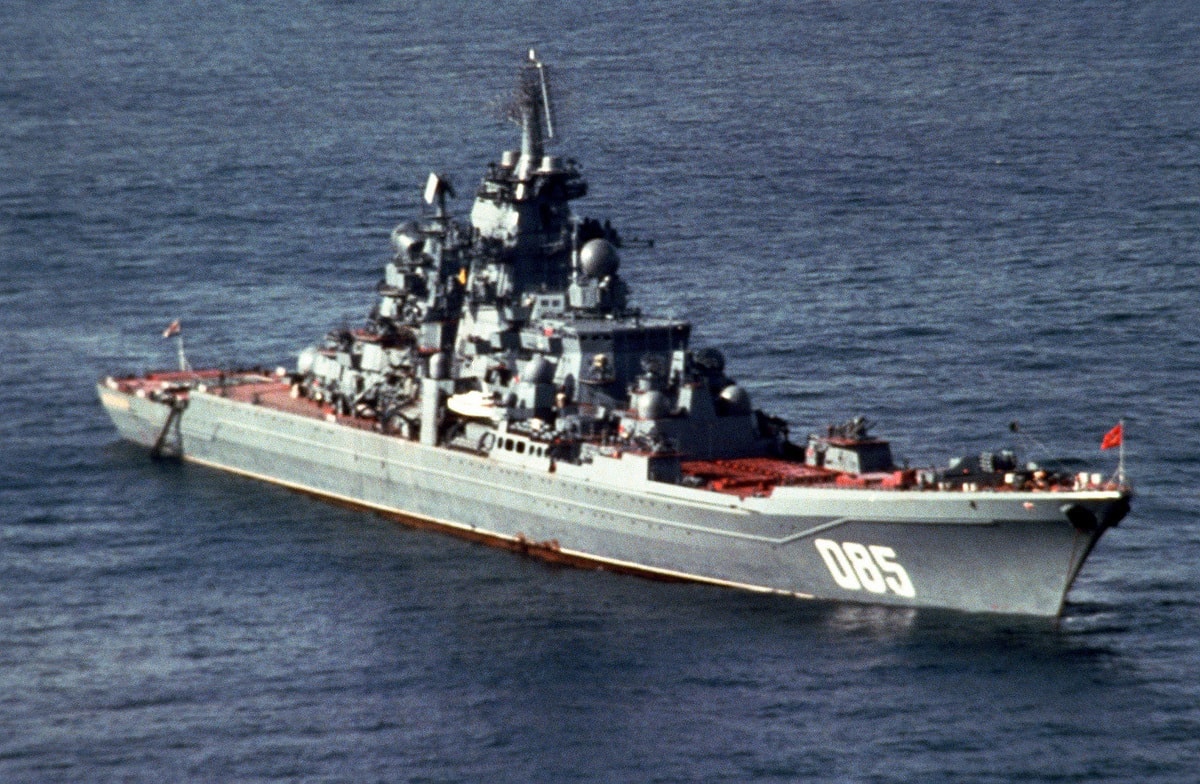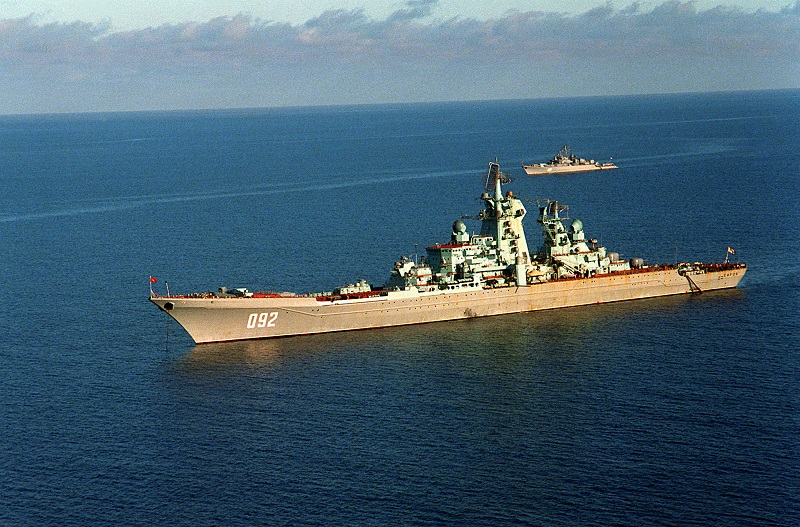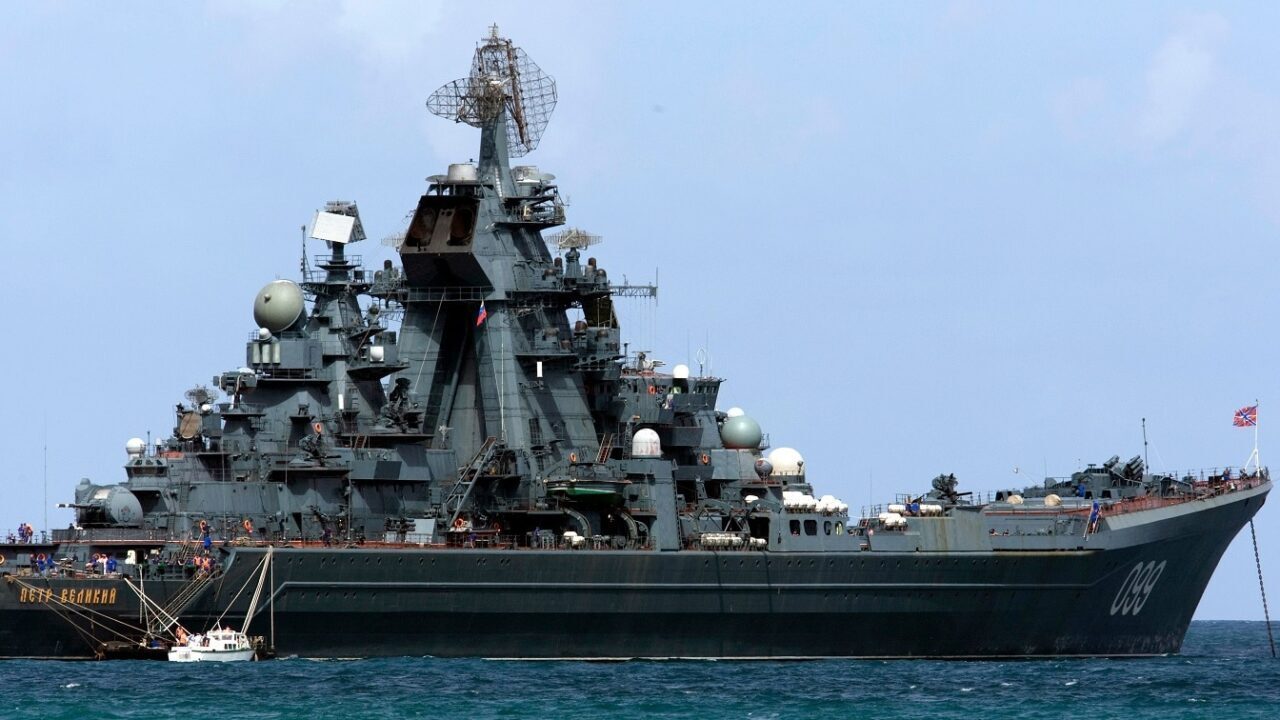Two Kirov-class battlecruisers are the Russian navy‘s largest surface ships beside its single aircraft carrier, the Admiral Kuznetsov. Two examples remain of the Kirov class in the Russian navy, and the Pyotr Velikiy and Admiral Nakhimov probably have a long service life ahead of them. However, the Kirov class has been dogged by issues relating to the refit and repair of the Admiral Nakhimov and the prospect of the same for the Pyotr Velikiy, raising questions about the future of the two battlecruisers.
A lot of firepower
The Kirov-class battlecruisers were a Soviet product of the late Cold War. Designed in part to go toe-to-toe with American carrier groups and strategic submarines, four of the ships were laid down between 1974 and 1986. Twenty P-700 anti-ship missiles gave the ships the firepower they needed to accomplish their core mission, and these formed the mainstay of the Kirovs’ arsenal.
The battlecruisers were designed to carry up to three helicopters as well as 96 S-300F surface-to-air missiles, 192 3K95 short-range surface-to-air missiles, and six AK-630 defense systems. Indeed, the Kirov battlecruisers carry significant combat power – yet Russia found it a growing burden to maintain them all. The navy decided in 2019 to scrap the Admiral Lazarev and the Admiral Ushakov, after previously announcing plans to refit the two battlecruisers in 2014.
Pyotr Velikiy is the flagship of Russia’s Northern Fleet and is known to take part in exercises in the Barents Sea. Two years after being commissioned into the Navy, the Pyotr Velikiy served as the lead ship in a disastrous 2000 exercise that saw the sinking of the nuclear submarine Kursk. This incident shook the Russian navy and was one of the first public relations scandals of Russian President Vladimir Putin’s tenure.
The Admiral Nakhimov is the Pyotr Velikiy’s sole surviving sister ship, and this Kirov-class battlecruiser has not seen active service since it was laid up for refit in 1997. It had entered the Soviet navy less than ten years prior. The Admiral Nakhimov was supposed to return to service after a few years, but it did not. The current estimate that the Admiral Nakhimov will be ready for service as soon as 2023 is just the latest of many such deadlines. Within the past five years alone, leaders in Russia’s military and in the United Shipbuilding Company have claimed that the battlecruiser would be ready by 2017, 2018, and 2021.
Despite official claims that its completion is imminent, it is not clear that refitting the Admiral Nakhimov on the desired timeline is feasible.
Modern struggles
Even if the Admiral Nakhimov is completed on time, it is possible that the Russian Navy would then immediately lay up the Pyotr Velikiy. Russian engineers are struggling to work with the Admiral Nakhimov’s outdated, enriched-uranium nuclear engine, and a full refit and modernization of the Pyotr Velikiy would probably run into similar issues. A significant part of the Admiral Nakhimov’s refit is the addition of new weapons systems. The Admiral Nakhimov is set to carry Kalibr and Oniks anti-ship missiles, as well as Otvet anti-submarine missiles. The Kirov-class battlecruisers are also prime candidates to receive Tsirkon anti-ship hypersonic cruise missiles.

A starboard bow view of the Soviet Kirov class nuclear-powered guided missile cruiser KALININ.

A port view of the Soviet nuclear-powered guided missile cruiser KIROV at anchor. In the background is a Soviet Krivak I-class guided missile frigate.
Russia appears to see the Pyotr Velikiy and Admiral Nakhimov as critical elements of its naval force development plans. But naval combat in the years to come will be different in many ways from the theoretical clashes that would have occurred between the U.S. and Soviet navies in the late Cold War. The remaining Kirov battlecruisers might struggle to keep up with those changes in the event of a shooting war – even if their modernization is completed successfully.
Wesley Culp is a Research Fellow at the Center for the Study of the Presidency and Congress. He regularly writes on Russian and Eurasian leadership and national security topics and has been published in The Hill and the Diplomatic Courier. He can be found on Twitter @WesleyJCulp.

